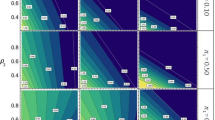Summary
In this paper, the mating systems of experimental populations of C. laminuligera and C. lutea are described. Outcrossing rates (t) were estimated for four populations of C. laminuligera and three populations of C. lutea using allozyme phenotypes of open-pollinated individual plant families. Populations were grown at densities of 1.0 × 1.0 m (low) and 0.04 × 0.3 m (high). Pollen and ovule frequencies and single locus and multilocus outcrossing rates were estimated for each population using the mixed-mating model. Multilocus estimates of t ranged from 0.83 to 0.98 and 1.00 to 1.01 for low and high density populations of C. laminuligera, respectively, and 0.17 to 0.26 and 0.36 to 0.54 for low and high density populations of C. lutea, respectively. C. laminuligera is predominantly allogamous; however, selfing rates as great as 17% were observed for this species. C. lutea is predominantly autogamous, but outcrossing rates as great as 54% were observed for this species. Outcrossing rates increased as density increased within C. lutea populations.
Similar content being viewed by others
References
Brown AHD, Barrett SCH, Moran GF (1985) Mating system estimation in forest trees: models, methods and meanings. In: Gregorius H (ed) Population genetics in forestry. Springer, Berlin Heidelberg New York, pp 32–49
Cardy BJ, Stuber CW, Wendel JF, Goodman MM (1983) Techniques for starch gel electrophoresis of enzymes from maize (Zea mays L.). Inst Stat Mimeograph Ser no 1317. North Carolina State Univ, Raleigh, NC
Clayton J, Tretiak D (1972) Amine-citrate buffers for pH control in starch gel electrophoresis. J Fish Res Board Can 29:1169–1172
Clegg MT (1980) Measuring plant mating systems. Bioscience 30:814–818
Efron B (1979) Bootstrap methods: another look at the jackknife. Ann Stat 7:1–26
Ellstrand NC, Torres AM, Levin DA (1978) Density and the rate of apparent outcrossing in Helianthus annuus (Asteraceae). Syst Bot 3:403–407
Graham SA (1988) Revision of Cuphea section Heterodon (Lythraceae). Syst Bot Monogr vol 20
Graham SA (1989) Cuphea: a new plant source of medium chain fatty acids. Crit Rev Food Sci Nutr 28:139–173
Graham SA, Hirsinger F, Röbbelen G (1981) Fatty acids of Cuphea (Lythraceae) seed lipids and their systematic significance. Am J Bot 68:908–917
Hirsinger F, Knowles PF (1984) Morphological and agronomic description of selected Cuphea germplasm. Econ Bot 38:439–451
Knapp SJ (1990) New temperate oilseed crops. In: Janick J, Simon JE (eds) Advances in new crops. Timber Press. Portland, Ore. pp 203–210
Knapp SJ, Tagliani LA (1989) Genetics of allozyme variation in Cuphea lanceolata Ait. Genome 32:57–63
Krueger SK, Knapp SJ (1990) Genetics of allozyme variation in Cuphea laminuligera and Cuphea lutea. J Hered 81:351–358
Levin DA, Kerster HW (1974) Gene flow in seed plants. In: Dobzhansky T, Hecht MK, Steere WC (eds) Evolutionary biology, vol 7. Plenum Press, New York, pp 139–220
Marty RL, O'Malley DM, Guries RP (1984) A manual for starch gel electrophoresis: new microwave edition. Staff Paper Ser no 20. University of Wisconsin, Madison, Wis
Ritland K, Jain S (1981) A model for the estimation of outcrossing rate and gene frequencies using n independent loci. Heredity 47:35–52
Schoen DJ, Clegg MT (1986) Monte Carlo studies of plant mating system estimation models: the one-pollen parent and mixed mating models. Genetics 112:927–945
Shaw DV, Kahler Al, Allard RW (1981) A multilocus estimator of mating system parameters in plant populations. Proc Natl Acad Sci USA 78:1298–1302
Vaquero F, Vences FJ, Garcia P, Ramirez L, Perez de la Vega M (1989) Mating system in rye: variability in relation to the population and plant density. Heredity 62:17–26
Wolf RB, Graham SA, Kleiman R (1983) Fatty acid composition of Cuphea seed oils. J Am Oil Chem Soc 60:27–28
Author information
Authors and Affiliations
Additional information
Communicated by A. L. Kahler
Rights and permissions
About this article
Cite this article
Krueger, S.K., Knapp, S.J. Mating systems of Cuphea laminuligera and Cuphea lutea . Theoret. Appl. Genetics 82, 221–226 (1991). https://doi.org/10.1007/BF00226217
Received:
Accepted:
Issue Date:
DOI: https://doi.org/10.1007/BF00226217




